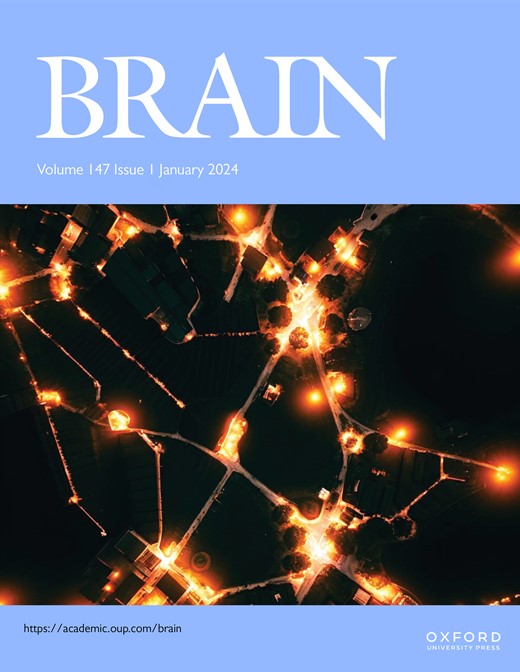Microgliosis and aberrant interferon response in Adar Mavs brain are rescued by PKR removal.
IF 11.7
1区 医学
Q1 CLINICAL NEUROLOGY
引用次数: 0
Abstract
Mutations in the human ADAR gene encoding adenosine deaminase acting on RNA 1 (ADAR1) cause Aicardi-Goutières syndrome 6 (AGS6); a severe auto-inflammatory encephalopathy with aberrant interferon (IFN) induction. AdarΔ2-13 null mutant mouse embryos lacking ADAR1 protein die with high levels of IFN-stimulated gene (ISG) transcripts. In Adar Mavs double mutants also lacking the Mitochondrial antiviral signaling (MAVS) adaptor, the aberrant IFN induction is prevented. Live pups are born and survive for two weeks, allowing ADAR1 function to be investigated. We have shown that early death of Adar Mavs mutants is rescued by the deletion of the Eif2ak2 gene encoding the antiviral dsRNA sensor protein kinase R (PKR). Here, we focused on characterizing the brain defects in Adar Mavs mutants and their dependencies on PKR. Mouse brains were collected on postnatal days 8 and 14, analysed by mass spectrometry, immunohistochemistry and RT-qPCR. The proteomic analyses showed upregulation of ISG-encoded proteins in the Adar Mavs double mutant and the morphological analyses confirmed the aberrant microgliosis in brains. Both are prevented in Adar Mavs Eif2ak2 triple mutants, indicating the key role of aberrant PKR activation; PKR expression is also increased by IFN signaling. Altered expression levels of transcripts encoding differentially expressed proteins and of ADAR-edited transcripts were confirmed by RT-qPCR. Analysis of the expression levels of transcripts in the brains of mutants expressing a catalytically-inactive ADAR E861A protein, revealed that the levels of some but not all altered transcripts are restored. A further group of proteins, downregulated in Adar Mavs are not rescued by removing PKR and may result from effects of loss of the widespread ADAR1 RNA editing known to occur in brain transcripts. This group includes several motor proteins, some of which have been reported to be encoded by ADAR-edited transcripts. In this study we show Adar Mavs double mutants exhibit an aberrant IFN response in the brain likely due to reactive microglia and astrocytes. Microgliosis, which is rescued in the triple mutant, is mostly dependent on aberrant PKR activation and is partially RNA-editing dependent.去除PKR后,Adar Mavs脑内小胶质细胞增生和异常的干扰素反应得以恢复。
编码作用于RNA 1的腺苷脱氨酶(ADAR1)的人类ADAR基因突变导致aicardii - gouti综合征6 (AGS6);伴有异常干扰素(IFN)诱导的严重自身炎症性脑病。AdarΔ2-13缺乏ADAR1蛋白的零突变小鼠胚胎死于高水平的ifn刺激基因(ISG)转录本。在Adar Mavs双突变体中也缺乏线粒体抗病毒信号(Mavs)适配器,异常的IFN诱导被阻止。活的幼崽出生并存活两周,从而可以研究ADAR1的功能。我们已经证明,Adar Mavs突变体的早期死亡是由编码抗病毒dsRNA传感器蛋白激酶R (PKR)的Eif2ak2基因的缺失所挽救的。在这里,我们专注于描述Adar Mavs突变体的大脑缺陷及其对PKR的依赖性。在出生后第8天和第14天收集小鼠大脑,采用质谱法、免疫组织化学和RT-qPCR进行分析。蛋白质组学分析显示Adar Mavs双突变体中isg编码蛋白上调,形态学分析证实了大脑中异常的小胶质细胞增生。这两者在Adar Mavs Eif2ak2三重突变体中都被阻止,表明PKR异常激活的关键作用;PKR的表达也因IFN信号传导而增加。RT-qPCR证实编码差异表达蛋白的转录本和adar编辑转录本的表达水平发生了改变。对表达催化失活的ADAR E861A蛋白的突变体大脑中转录本表达水平的分析显示,部分(但不是全部)改变的转录本水平得到恢复。在Adar Mavs中下调的另一组蛋白质不能通过去除PKR而得到保护,这可能是由于已知在大脑转录本中发生的广泛的ADAR1 RNA编辑丢失的影响。这一组包括几种运动蛋白,其中一些据报道是由adar编辑的转录本编码的。在这项研究中,我们发现Adar Mavs双突变体在大脑中表现出异常的IFN反应,可能是由于反应性小胶质细胞和星形胶质细胞。在三重突变体中获救的小胶质瘤主要依赖于异常的PKR激活,部分依赖于rna编辑。
本文章由计算机程序翻译,如有差异,请以英文原文为准。
求助全文
约1分钟内获得全文
求助全文
来源期刊

Brain
医学-临床神经学
CiteScore
20.30
自引率
4.10%
发文量
458
审稿时长
3-6 weeks
期刊介绍:
Brain, a journal focused on clinical neurology and translational neuroscience, has been publishing landmark papers since 1878. The journal aims to expand its scope by including studies that shed light on disease mechanisms and conducting innovative clinical trials for brain disorders. With a wide range of topics covered, the Editorial Board represents the international readership and diverse coverage of the journal. Accepted articles are promptly posted online, typically within a few weeks of acceptance. As of 2022, Brain holds an impressive impact factor of 14.5, according to the Journal Citation Reports.
 求助内容:
求助内容: 应助结果提醒方式:
应助结果提醒方式:


